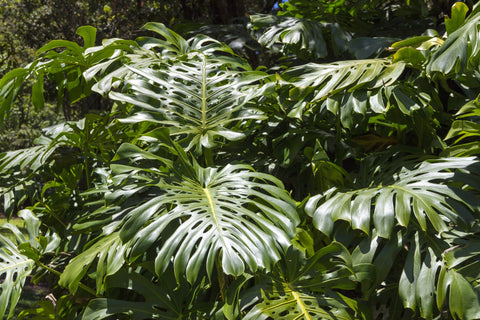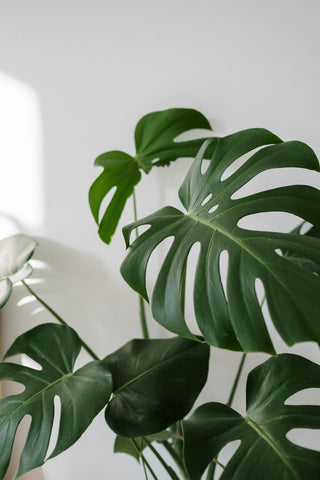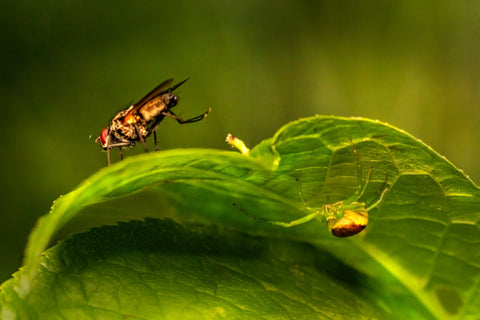Growing green plants in our living spaces is a healthy and satisfying practice, adding beauty and serenity to the décor. Live houseplants clean indoor air and add a sense of peacefulness, stress-relief and boost productivity in work environments.
There are many popular plants grown indoors as houseplants, but one that stands out is the Monstera Plant. This giant indoor plant can grow 10 to 15 feet tall and 8 feet wide. A striking plant with leaves that can measure 18 inches across, it adds greenery, beauty, and uniqueness to any indoor setting.
This reference will tell you everything you need to know about growing and caring for your Philodendron Monstera.
About the Philodendron Monstera

Philodendron Monstera, Swiss Cheese Plant, or Monstera Deliciosa Plants, gets its name and nicknames for a couple of its unique characteristics.
- Monstera Deliciosa is for its large size (Latin monstrum means monster) and fruit that tastes like banana and pineapple.
- Swiss Cheese Plant comes from the mature leaves with large elliptic holes, or fenestrations.
- Philodendron Monstera is from being in the same plant family as philodendrons, the arum family, a family with more than 3,500 species including the peace lily and pothos.
Is a Monstera Deliciosa a philodendron? Technically, no, but it is in the same family and is often referred to as a philondendron.
Did You Know?
Monstera Deliciosa is native to Central America and tropical environments where they grow naturally as outdoor plants. Monstera Deliciosa grow up to 70 feet into large trees. In their natural habitat, Monstera plants trail huge cord-like aerial roots which absorb moisture from the surrounding air. Monstera Deliciosa produces white spiky flowers with spathes that turn into green scale-covered edible fruits.
The flowers take a year to turn into fruit, which are mature when the green scales start to loosen from the bottom to the top. The ripe fruit is fragrant, with edible, fleshy fruit inside. The fruit is rarely seen on houseplants, but if you live in a tropical climate and grow this houseplant outdoors, you will see fruits after three years of growing.
Although Philodendron Monstera can produce fruit, the rest of the plant is not edible. It is mildly toxic when ingested by humans and animals. Make sure it is out of reach from small children or pets.
Where to Buy a Philodendron Monstera

Philodendron Monsteras can be found for sale online, in greenhouses that grow tropical houseplants, and in garden centers like Home Depot and Lowes. If you are lucky and know someone who has a Monstera and is willing to part with a cutting, you can grow one of these indoor houseplants yourself. If you are looking for a smaller version of the Monstera plant, you can purchase a Split Leaf Philodendron. which has smaller feather-shaped leaves that are split rather than fenestrated.
Philodendron Monstera Care

It’s easy to grow a Philodendron Monstera if you know the ideal growing conditions for these indoor houseplants. Your new plant will grow well with the right attention to environmental needs for water, light, soil, and temperature. Here is how you can properly care for a Monstera.
Light
Since Monstera Plants have a natural habitat of warm and humid jungle environments, they do best in bright indirect sunlight. It will grow in lower light conditions but will not do well with low light. You will notice a leggy growth if you leave your Monstera is getting too little light. During the winter months, Monstera's can grow with direct sunlight. These indoor plants grow best in bright indirect light.
You might be wondering, how much light is too much? Do not leave your Monstera in direct light, such as in a sunny window, or the leaves will get burned, turn yellow and die. The best lighting conditions for healthy growth would be in a room that gets bright indirect sunlight. Look for a room with indirect light from southern-facing windows.
Water
Even though Philodendron Monstera is native to tropical climates, it does not like water-logged soil, or wet feet. Letting it sit in constantly wet soil or overwatering can cause root rot and will eventually kill it.
Well draining soil is essential to drain excess water away from the roots, to prevent root rot and let the roots develop. Make sure to let it dry out somewhat between watering to drain excess water to improve root health. Letting the soil dry out completely, or leaving the Monstera without water for too long is not good, and will also stress and eventually kill it.

Create a watering schedule to consistently follow for your Monstera. Watering once weekly with tap water or demineralized water is recommended. Do not let the plant wilt often. Use a moisture meter and keep track of when you water to ensure the right moisture levels to encourage growth.
Temperature
Coming from native tropical climates, your Philodendron Monstera needs to be kept in a warm environment. The ambient temperature needed is between 60 and 80 degrees, with the warmer the better, and never below 55 degrees.
Sudden drops in temperature will stress the plant and could damage it if they happen too often. Also avoid cold drafts from doors or windows, and any blowing air from heating and cooling vents. Consistent sheltered warmth will keep your Monstera comfortable and healthy.
Humidity
As a tropical rain forest plant, Monstera likes humidity, and normal household air is probably going to be too dry. You’ll need to add moisture to its environment for optimal growth.
Use a spray bottle to spray the Monstera a couple of times daily, or place a pebble tray filled with water nearby to add moisture to the air around the plant. If possible, a humidifier in the room is even better.

Soil
A lightweight, fresh potting mix for container growing is best for Philodendron Monstera. You can add organic matter like mushroom compost for a balanced fertilizer, or compost you create with a Lomi Home Composter.
Avoid overly heavy, compacted soils. Remember, the native environment is tropical jungles with a lot of organic matter like decaying leaves, sticks, bark, and other tree and undergrowth litter.
Feeding
Even if you have added organic matter to the soil, you should fertilize your Monstera once a month when it’s actively growing. Use a tropical plant fertilizer or all-purpose plant food. Tropical plants need less phosphorus, so use a fertilizer formulated especially for tropical plants with a lower phosphorus ratio than the other two common nutrients nitrogen and potassium, plus added iron and magnesium.
If you’ve planted with a rich potting mix and organic matter, use fertilizer at half strength once a month during the growing season. A monstera's growing season is from spring through summer. No fertilizing is needed in fall and winter when the plant is not in its growing season. Be careful not to over-fertilize the plant and to use well draining mix.

Repotting
Your Philodendron Monstera likes to be pot-bound, so keep an eye on it as it grows, and only repot it when the roots are growing out of the drainage holes.
When you see new roots growing out of the bottom of the pot, find a pot one size bigger than the one it’s in. Add fresh fertilizer and organic matter to the bottom of the new pot, tap the plant out of the current pot, and put it in the bigger pot, filling in with more fresh fertilizer. Push the root ball firmly into the new soil, and pat it down to fill in any air pockets. Water and mist your newly repotted plant.
Pruning and Propagating Your Swiss Cheese Plant

The Monstera plans can be easily pruned to control it's height and width. Be sure you are using a use a clean, sharp pair of scissors or pruning shears (it’s a good idea to wipe them off with bleach). Snip off the end of a vine just below a leaf node, being careful not to cut into a node.
The cuttings can be dipped in rooting powder and planted directly in moist fertilizer to start new plants, or put in water to grow roots for planting later. Monstera cuttings in water in glass make attractive displays on walls or shelves.
Problems to Watch for with Philodendron Monstera

Tropical plants are generally easy to take care of, but you should watch for the following conditions that will affect healthy growth and longevity, such as wilting or yellow leaves.
Wilting
You don’t want to see wilting as it means there’s something preventing your plant from taking up enough water to be healthy and grow. The following issues cause wilting and need immediate attention:
Not Enough Water
- Monstera plants will wilt and eventually die without enough water.
- Take immediate action when you see wilted leaves by checking the soil moisture level with a moisture meter or sticking your finger an inch or two into the mix. If the soil is dry, you need to water the plant with demineralized water and mist the leaves well. Let the water run out of the bottom of the pot several times. Putting it into the bath tub and letting the shower run on it is a good first aid for a wilted plant with fertilizer that’s dried out.
- If you have found your plant wilted, you should check the area where you’ve been keeping the plant for drafts, dry air, warm air blowing on it, or direct sunlight. These conditions can cause the soil to dry quickly and affect the plant’s wellbeing, requiring a more suitable location.
Too Much Water
Interestingly, too much water will also cause wilting, because water-logged roots can’t take up water efficiently which will cause root rot. If there is wilting and the soil is wet, there may also be root damage.
- If there is wilting and wet soil, tap the plant out of the pot onto paper towel or a plastic bag and inspect the roots.
- If there are rotted roots, gently cut them away and replace the wet soil with fresh, loose dry soil.
Dry Air
Philodendron Monstera’s native environment is tropical jungles with high humidity levels. Where you locate your plant needs high humidity, at least 60 to 90 percent. Lower humidity levels may stress the plant. A hygrometer will tell you the humidity level and then you can adjust with pebble trays with water or a humidifier if necessary.
Pests

Like any indoor plants, common pest can be a problem and threat to your Monstera’s health and wellbeing. Common pests include fungus gnats, aphids, spider mites, and thrips. Common pests may show up when a plant is stressed from neglect or improper care, or if exposed to other infected plants. If pests are not addressed as soon as they appear, they will multiply, spread to surrounding plants, and do real damage.
At the first signs of insect activity, inspect the plant closely, looking under leaves, between stems, in the fertilizer, and in the roots. Take action immediately with any insect pests by washing them off leaves with a damp sponge and stems with soapy water. Then treat the fertilizer with neem oil, a natural pesticide. Check any surrounding plants for pests also and treat them if found.
Diseases

Like many indoor plants, Swiss Cheese Plant can be susceptible to disease if not cared for properly. Like other plants in the same family, Monstera leaves are affected by Septoria Leaf Spot and Alternaria Leaf Spot causing fungal growth from over-watering issues. Septoria causes yellowing leaves, and Alternaria causes brown spots on leaves.
If you see either of these leaf deformities like perforated leaves, immediate action is needed to save the plant and restore it to health. Remedy the wet soil condition and treat with a copper-based fungicide. Remember that attention to the proper watering conditions protects the health and longevity of your plant.
Monitoring The Soil's Moisture Content
One of the most important things to keep your Monstera healthy and disease-free is to pay attention to the moisture content of its soil. Avoid water-logging the mix and letting it dry out completely to the point of wilting. These are two extremes that will stress the plant and encourage diseases and susceptibility to pests.
A few tools mentioned above will help you avoid the mistakes of over and under-watering your Philodendron Monstera:
- A watering logbook to write down each date and time you water your Monstera will help you keep to a once-weekly watering. Adding information such as how much water you used and how you watered, either with a watering can or putting your plant in the sink or bathtub to run water into it for a few minutes will also help you keep on track with the right amount of watering.
- A moisture meter that tells you if the soil in the middle and bottom of the container is dry, moist, or wet helps you avoid over-watering. Don’t add water if the meter reads wet and avoid letting the soil get to the lowest dry reading of 0, noting in your watering logbook what the moisture meter reading is each time you check it.
- A hygrometer that measures the humidity in the surrounding air will also help you monitor the water needs of your Swiss Cheese Plant. Knowing what the humidity level is, and adjusting the moisture in the air to the right percentage, helps your plant thrive stress-free and remain at optimum levels to absorb water from roots and moisture from the air with leaves. Knowing the humidity levels lets you adjust either water-filled pebble trays or humidifier near your plant so there’s no guess-work.
Philodendron Monstera is a beautiful tropical houseplant with large leaves that is generally easy to care for when you know its environmental needs. Keep it warm, pay attention to water and humidity needs, locate it in bright indirect light but not direct sunlight, fertilize it during active growth, and watch for insect pests.
If you like vining plants, and like to propagate new plants from cuttings, it’s the perfect plant for the houseplant hobbyist. It also makes a wonderful statement plant to round out any indoor décor.
